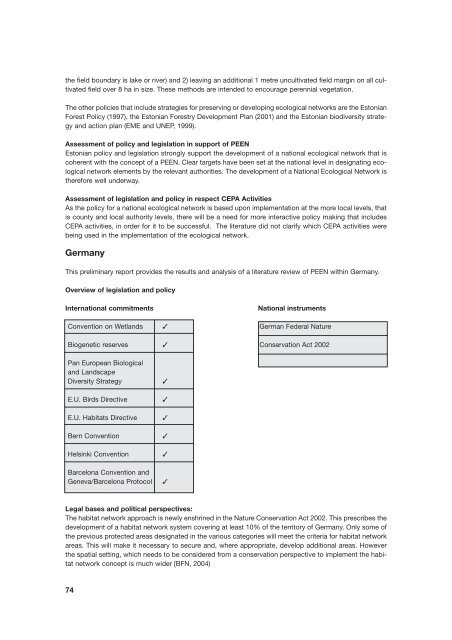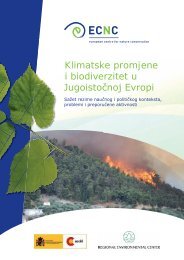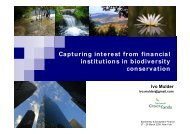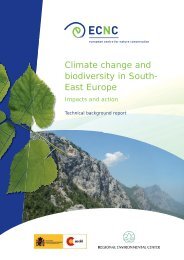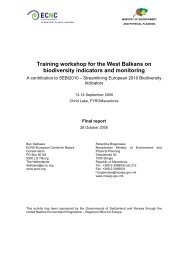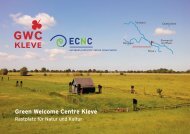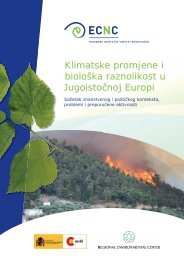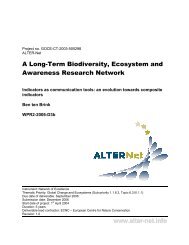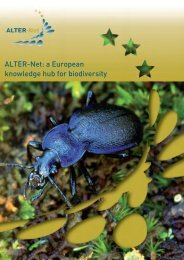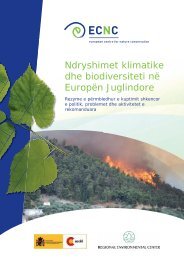The Act on Sustainable Development 1997 (as amended) lays down <strong>the</strong> principles of <strong>the</strong> national strategyand provides <strong>the</strong> legal basis for implementing <strong>the</strong> principles of sustainable development. This Act containsspecial articles concerning ecological networks, i.e. ecological considerations at spatial planning anddevelopmental planning.The Act on Protection of Natural Objects 2001 (as amended) is one of <strong>the</strong> main legal instruments concerningnature conservation. This Act determines <strong>the</strong> nature of protection and <strong>the</strong> procedure for <strong>the</strong> protectionof territories (landscapes), single objects of nature (geomorphologic features), plant, fungi and animalspecies. It determines <strong>the</strong> rights and responsibilities of landowners, land users and o<strong>the</strong>r persons in regardto protected natural objects and regulates <strong>the</strong> introduction and reintroduction of protected species. Bysetting <strong>the</strong> general framework for designating protected areas, and for working out <strong>the</strong>ir protection rules,territorial zoning and management plans, <strong>the</strong> Act provides a strong legal support for preservation of coreareas of <strong>the</strong> ecological network.The Act on Protection of Marine and Freshwater Coasts, Shores and Banks (1995) stipulates <strong>the</strong> principlesfor using and protecting <strong>the</strong> Estonian coast and shoreline. The Act is very important for preserving ecologicalcorridors along <strong>the</strong> coastline, lake-shores and river banks.Spatial planning, including settlements, industry and <strong>the</strong>ir infrastructure, which exert an impact on a considerableshare of natural areas, is organised by <strong>the</strong> Act on Planning and Building 1999 (as amended). TheAct provides <strong>the</strong> legal background for designing an ecological network as a part of <strong>the</strong> county spatial planningprocess. The county plan has legal power in Estonia. The county spatial plan is considered to be <strong>the</strong>main development plan, which sets <strong>the</strong> legal framework for land use and o<strong>the</strong>r activities. The design of <strong>the</strong>green network is carried out at county level (planners use <strong>the</strong> term “green network” instead of “ecologicalnetwork”).The Act on Wildlife Protection (1998) sets a legal basis for <strong>the</strong> protection and preservation of migratoryroutes. All activities, such as, construction and planning of roads, communication lines or rebuildingshould take into consideration <strong>the</strong> existing migratory routes of wildlife.The o<strong>the</strong>r laws and regulations which could indirectly support ecological network principles, include <strong>the</strong>Act on Forestry (1998, amended in 1999), <strong>the</strong> Act on Hunting Management (1994), <strong>the</strong> Act on LandImprovement (1994), <strong>the</strong> Act on Water (1994, amended 1996), <strong>the</strong> Act on Fisheries (1995, amended in1996, 1998, 2000).Several environmental policies, for example, <strong>the</strong> Estonian National Environmental Strategy and <strong>the</strong>Estonian Environmental Action Plan, are oriented towards <strong>the</strong> development of ecological networks inEstonia. The Estonian National Environmental Strategy, approved in 1997, sets a goal to ensure <strong>the</strong> preservationof viable populations of local plant and animal species, natural and semi-natural communitiesand landscapes typical of Estonia (EME, 1997). The long-term strategy “Estonia – vision 2010” contains achapter on “green networks” and a schematic map of an Estonian green network.The National Agri-Environmental Program supports <strong>the</strong> development and preservation of ecological networksat local (farm, agricultural enterprise) level. Currently, <strong>the</strong> project on “Development of an Agri-environmentalScheme for Estonia” is on-going (Sepp, 1999).The National Agri-Environmental program is intended:To maintain and protect valuable natural, semi-natural wildlife habitats, landscapes and <strong>the</strong>ir elements,which are associated with small biotopes such as ponds, hedges, stone heaps, stone walls, etc.;To maintain, protect and improve <strong>the</strong> visual appearance of <strong>the</strong> farm by maintaining, protecting and improvingall farm and field boundaries, including hedges and stone walls;To maintain and encourage extensive crop production methods on all cultivated land by: 1) leaving at leasta 3 metre wide unsprayed and “headland” on all cultivated fields (this must be increased to 10 metres if73
<strong>the</strong> field boundary is lake or river) and 2) leaving an additional 1 metre uncultivated field margin on all cultivatedfield over 8 ha in size. These methods are intended to encourage perennial vegetation.The o<strong>the</strong>r policies that include strategies for preserving or developing ecological networks are <strong>the</strong> EstonianForest Policy (1997), <strong>the</strong> Estonian Forestry Development Plan (2001) and <strong>the</strong> Estonian biodiversity strategyand action plan (EME and UNEP, 1999).Assessment of policy and legislation in support of PEENEstonian policy and legislation strongly support <strong>the</strong> development of a national ecological network that iscoherent with <strong>the</strong> concept of a PEEN. Clear targets have been set at <strong>the</strong> national level in designating ecologicalnetwork elements by <strong>the</strong> relevant authorities. The development of a National <strong>Ecological</strong> <strong>Network</strong> is<strong>the</strong>refore well underway.Assessment of legislation and policy in respect CEPA ActivitiesAs <strong>the</strong> policy for a national ecological network is based upon implementation at <strong>the</strong> more local levels, thatis county and local authority levels, <strong>the</strong>re will be a need for more interactive policy making that includesCEPA activities, in order for it to be successful. The literature did not clarify which CEPA activities werebeing used in <strong>the</strong> implementation of <strong>the</strong> ecological network.GermanyThis preliminary report provides <strong>the</strong> results and analysis of a literature review of PEEN within Germany.Overview of legislation and policyInternational commitmentsConvention on WetlandsBiogenetic reserves<strong>Pan</strong> <strong>European</strong> Biologicaland LandscapeDiversity StrategyE.U. Birds DirectiveE.U. Habitats DirectiveBern ConventionHelsinki ConventionBarcelona Convention andGeneva/Barcelona Protocol✓✓✓✓✓✓✓✓National instrumentsGerman Federal NatureConservation Act 2002Legal bases and political perspectives:The habitat network approach is newly enshrined in <strong>the</strong> Nature Conservation Act 2002. This prescribes <strong>the</strong>development of a habitat network system covering at least 10% of <strong>the</strong> territory of Germany. Only some of<strong>the</strong> previous protected areas designated in <strong>the</strong> various categories will meet <strong>the</strong> criteria for habitat networkareas. This will make it necessary to secure and, where appropriate, develop additional areas. However<strong>the</strong> spatial setting, which needs to be considered from a conservation perspective to implement <strong>the</strong> habitatnetwork concept is much wider [BFN, 2004)74
- Page 1 and 2:
european centre for nature conserva
- Page 3 and 4:
Published by:This publication was m
- Page 5 and 6:
Executive SummaryIn 2003, ECNC publ
- Page 7 and 8:
●●The study has highlighted the
- Page 9 and 10:
NetherlandsEstoniaNorwayUnited King
- Page 11 and 12:
PEEN - a Europe wide ecological net
- Page 13 and 14:
Experiences at the EU level, regard
- Page 15 and 16:
there may also be huge variations i
- Page 17 and 18:
on the effectiveness of implementat
- Page 19 and 20:
e the working group involving natio
- Page 21 and 22:
Opportunities or challenges for eco
- Page 24 and 25: As mentioned above, there are a lot
- Page 26 and 27: It was felt by some respondents tha
- Page 28 and 29: gained by the work of the NGOs, sci
- Page 30 and 31: nature conservation societies (Prov
- Page 32 and 33: ● Local level support for interna
- Page 34 and 35: istics of the Norwegian landscape,
- Page 36 and 37: policymaking, involving stakeholder
- Page 38 and 39: Some respondents thought a map was
- Page 40 and 41: semi-natural habitats. One responde
- Page 42 and 43: In Scotland, there is a lot of work
- Page 44 and 45: policymakers, researchers, scientis
- Page 46 and 47: Experience and expertise:Over the p
- Page 48 and 49: knowledge also exists regarding the
- Page 50 and 51: At an international level, this is
- Page 52 and 53: lack of integration of policies reg
- Page 54 and 55: ottom-up approach of PEEN requires
- Page 56 and 57: 5 ReferencesSandra Rientjes & Kater
- Page 58 and 59: Methodological Outline●●●●
- Page 60 and 61: CPA 1 A3Communicating PEENDESK STUD
- Page 62 and 63: IntroductionThe desk review of the
- Page 64 and 65: The following two tables, adapted f
- Page 66 and 67: Habitats DirectiveAssessment of the
- Page 68 and 69: Ramsar ConventionAssessment of the
- Page 70 and 71: Assessment ofCommunication,Educatio
- Page 72 and 73: and other European states, four rep
- Page 76 and 77: In Germany nature conservation by l
- Page 78 and 79: The management of protected areas f
- Page 80 and 81: The NvM and the NMP4 are devoted to
- Page 82 and 83: Assessment of policy and legislatio
- Page 84 and 85: A Species Action Plan (SAP) has bee
- Page 86 and 87: CPA 1 A3Communicating PEENExecutive
- Page 88 and 89: Practical experiences with developi


